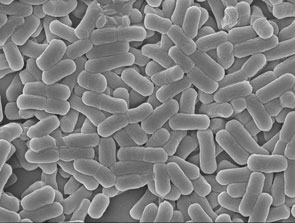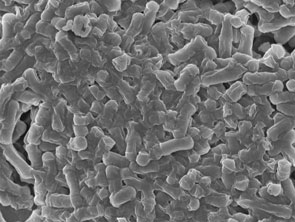| Posted: Nov 10, 2009 | |
Sharper and faster nanodarts kill more bacteria |
|
| (Nanowerk Spotlight) A newly published antibacterial activity mechanism study demonstrates how a single walled carbon nanotube (SWCNT) kills bacteria by the physical puncture of bacterial membranes. The nanotubes would constantly attack the bacteria in solution, degrading the bacterial cell integrity and causing the cell death. This work elucidates several factors controlling the antibacterial activity of pristine SWCNTs and provides an insight in their toxicity mechanism. | |
| We have written about nanotechnology's complicated risk-benefit dichotomy before: the fact that the same nanomaterial can be used in a controlled environment for beneficial nanotherapeutic applications but in an uncontrolled environment can give cause for health and environmental concerns. For instance, even if a particular nanoparticle appears not to be toxic by itself, the interaction between this nanoparticle and other common compounds in the human body may cause serious problems to cell functions. On one hand, this effect could be used to great advantage in nanomedicine for killing cancer cells. On the other hand, unfortunately, it is unknown at present whether the same effect could be observed with healthy cells as well. | |
| With regard to carbon nanotubes, in early toxicological studies, researchers obtained confounding results – in some studies nanotubes were toxic; in others, they were not. The apparent contradictions were actually a result of the materials that the researchers were using, not appreciating that 'carbon nanotubes' are really 'carbon nanotubes + metal + amorphous impurities'. Ignoring these impurities prohibits scientists from fully understanding the material's electronic character, environmental transport, transformation, and ecotoxicology (see: "Comparing apples with oranges – the problem of nanotubes risk assessment "). | |
| "The potential applications of carbon nanotubes have raised concerns about their potential impacts on human health and environmental safety," Yuan Chen tells Nanowerk. "Various, sometimes even contradictory, toxicity and antibacterial activity mechanisms have been proposed for carbon nanotubes. We are the people who are handling this material everyday and we want to know exactly what the toxicity mechanism is and how can us maximizing their application potential while minimizing their risks." | |
| Chen, an assistant professor at the School of Chemical and Biomedical Engineering at Nanyang Technological University, continues: "When I read previous papers on this topic, I notice that the characterizations of carbon nanotubes in toxicity studies are very limited. However, almost all commercial available carbon nanotube samples are mixtures of many species including metal residues, nanosize catalyst supports, amorphous carbon, carbon nanoparticles, graphite, carbon fibres, single walled carbon nanotubes and multi-walled carbon nanotubes. Without knowing exactly what is in the nanotube samples, the reliability of those previous conclusions remains questionable. This has motivated me to conduct our recent work." | |
  |
|
| SEM images of (left) B. subtilis after incubation with saline solution without SWCNTs and (right) B. subtilis after incubation with SWCNTs. (Images: Dr. Yuan Chen, Nanyang Technological University) | |
| In the November 6, 2009 online issue of ACS Nano ("Sharper and Faster 'Nano Darts' Kill More Bacteria: A Study of Antibacterial Activity of Individually Dispersed Pristine Single-Walled Carbon Nanotube"), Chen and his team report a comprehensive study on the antibacterial activity of pristine SWCNTs. | |
| Specifically, Chen's work presents four novel findings: | |
| 1) The team demonstrates that individually dispersed SWCNTs are more toxic than SWCNT aggregates toward four types of bacteria. Previous studies have been using SWCNT aggregates for antibacterial studies. UV-vis-NIR absorption spectroscopy allows researchers to monitor the aggregation of SWCNTs for antibacterial studies. | |
| 2) Controlled experimental results show that inhibiting cell growth and oxidative stress are not the major causes responsible for the death of cells. This clarifies controversies in previous studies. | |
| 3) Using SWCNTs with controllable amounts of metal residues, Chen's team shows that cobalt metal residues up to 1 µg/ml have no detrimental effects on SWCNT antibacterial activity. This also has not been shown before. | |
| 4) Using atomic force microscope measurement conducted in liquid, the team is first to demonstrate that the mechanical properties of bacteria are correlated with their vulnerability toward the physical puncture induced by SWCNTs. | |
| The potential applications of this work include two aspects – nanomedical and nanotoxicological. "With regard to therapeutic applications, in fighting bacteria or diseases such as cancer cells, if we want to enhance the antibacterial activity (or toxicity), we should enhance the SWCNT physical punctures by dispersing them individually, increasing concentration, elevating their mobility," says Chen. "If we want to minimize their health and environmental risks, we should keep them immobilized, or even trap them in a soft polymer shell." | |
| He further points out that precise controls using scalable methods are needed for many potential applications of carbon nanotubes. These areas for controls include the structure of single walled carbon nanotube such as chirality, length, and orientation; selective functionalization on nanotubes with specific locations and functional group density; controlled interaction between nanotube and biological systems. | |
| "The challenges" says Chen, "are twofold: Precise control at the nanoscale is difficult; and most methods proposed so far are not scalable – they usually only handle tiny amounts of samples in research labs which limits their chances of commercialization." | |
 By
Michael
Berger
– Michael is author of three books by the Royal Society of Chemistry:
Nano-Society: Pushing the Boundaries of Technology,
Nanotechnology: The Future is Tiny, and
Nanoengineering: The Skills and Tools Making Technology Invisible
Copyright ©
Nanowerk LLC
By
Michael
Berger
– Michael is author of three books by the Royal Society of Chemistry:
Nano-Society: Pushing the Boundaries of Technology,
Nanotechnology: The Future is Tiny, and
Nanoengineering: The Skills and Tools Making Technology Invisible
Copyright ©
Nanowerk LLC
|
|
|
Become a Spotlight guest author! Join our large and growing group of guest contributors. Have you just published a scientific paper or have other exciting developments to share with the nanotechnology community? Here is how to publish on nanowerk.com. |
|
